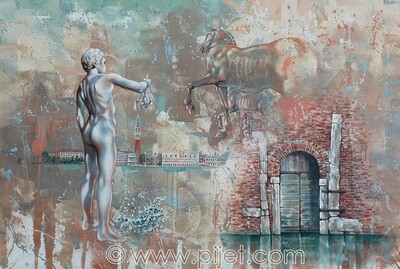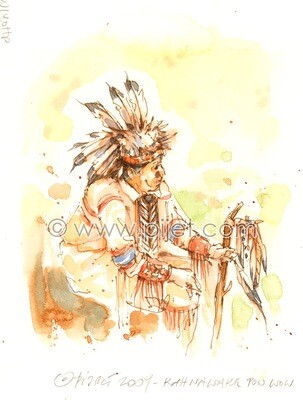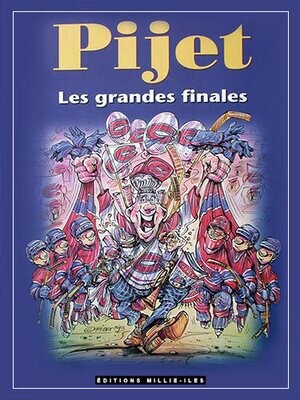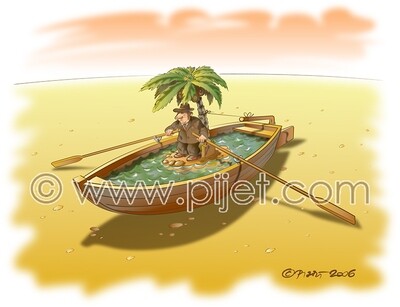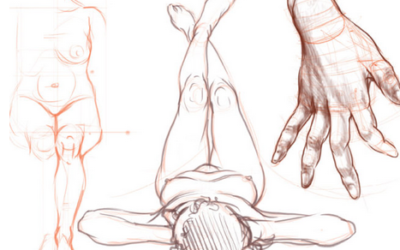Olympic Games
The Olympic games, one of the most glorious and respected events of our century, were born in Ancient Greece. The official date of the first games is estimated at 776 BC. The date is considered controversial because of the complexity of Greek calendar[1]. However it doesn’t change the fact of its great influence on many aspects of social live in Ancient Greece, as well as at the present.
The idea of great peaceful reunion of different Greek cities was innovative, despite the fact of territorial divisions[2] of first competitions, which completely disappeared later, and the constant rivalry between them.
The Games, as well as many other important events[3] to the Greeks are well documented in art of sculpture and pottery painting, as a source of visual information about them, living important detailed references of their functionality. The examination of chosen samples of pottery executed during The Geometric, Archaic, and Classical periods, and the process of documentation of various sporty events are quite extended, and interesting to go through. The pottery painting itself is a visual encyclopedia of everyday life of Ancient Greece, depicting their religious believes and secular interests in many aspects of their social activities. It is important to preserve them for the future generations as an excellent source of information about the early arising of Western Culture.
In those times it was the only visual, easy to spread around, information about the greatness of Greek Art and Culture.[4] Greek vase painting was a fast form of art executed for sale, which might be compared to today’s editorial illustration expressing the interests of many important aspects of our society. The functionalism of Greek pottery and the information painted on it might be comparable with photographic images of our modern realities, distributed in the newspapers. This comparison might seem exaggerated to some, but it certainly make a sense. It was a traveling documentary of ancient times and concerns of Greek society reflected on everyday used objects. At the same time they served to promote, apart from many others subjects, the athletic events of Greece. As for us at the present, it is an excellent source of information about the roots of our Western Civilization.
The sport, as an entertaining social activity, was always present in many cultures, but the Greeks brought the importance of different physical exercises to a higher level possible by integration of athletic training, as an important element of their social structures and education. There were four the most important centers of athletic events: Games at Olympia, Pythian Games at Delphi, The Isthmian Games at Isthmus, and The Nemean Games at Nemea. All of them were situated in the beautiful environments, with gradually developed athletic and religious facilities. Some of them became sanctuaries of religious devotion, as Delphi to Apollo, and Olympia to Zeus. Besides those, there were many competitions organized locally. Almost each big city had some locally created sport related events. Sport for Greeks was an integral part of their existence. According to the Greeks, the mind can’t be separated from the body, as well as the body without mind has no values. The body and the mind were completing themselves as the one. The Greeks considered the physical excellence as an approach to the Gods, and the physical effort as a way of personal contact with them. The sportive mind to the Ancient Greeks was an important element of their cultural values, the most significant of which was a personal freedom of mind and body. However, respecting the law of social order was an obligation to all Greek citizens.
The principals of Ancient Greek culture were united in their public festivities. The Olympic games had a special place in those events. The temporary unification of all Greeks, gathered to compete in the highest sport spirit, apart from existing animosities between them, proofs the degree of importance associated with those competitions.
It is possible that the first Olympic games in 776 BC were preceded by the long tradition of sport competitions, starting already as early as in the Minoan period. The Bull-leaping frescos[5] (see fig. 1) from Knossos, or the Boxing boys (see fig. 2) from Thera, both dated between 16th to 17th century BC, according to different sources, are early existing proofs of athletic activities of the Minoan civilization. The culture of sport events was transmitted to continental Greece: first to the Mycenaean and then to the rest of Greece. However, the earliest sport activities can be traced to the East and Egypt[6] approximately 3000 BC, and probably much farther than that. There are not too many samples of iconography of sport from the Mycenaean civilization, but from the few remaining we know that they introduced the Chariot-races in 1300 BC. The Mycenaean evidences show that the most popular sports were: Running, Wrestling, Chariot-races, and Boxing, which are understandable in regards to their warlike society. For Mycenaean’s the physical shape was extremely important for succeeding on the battlefield.
The most iconographic evidence of different sport activities come from Geometric, Archaic, and Classical periods. There are many theories concerning the beginning of sport competitions in Greece. Apart from Homer’s and Mythological sources, it is believed that it all started with the death of the king, so the games began as funeral celebrations. Homer wrote about it in “Iliad”, describing how Achilles initiated the funeral games to honor Patroklos, his killed friend. Many of Mycenaean funeral steles have depicted scenes of Chariot racing, Boxing, and Running on them, which would confirm the theory of funeral origins of the athletic competitions.[7]
There is no written documentation concerning the structure of the games in their early stage. The only recorded information about it comes from Homer’s description of those events in “Iliad” and “Odyssey”. In the Minoan and Mycenaean pottery there are some iconography referring to the sport events, dating from approximately 1300 BC. However, the most references to the different documentary aspects of athletic competitions are illustrated on the black-figure pottery of Orientalizing, Archaic, and Classical periods, as well as on red-figures pottery of the late Archaic and Classical periods.
The Greek pottery of that era gives a lot of visual information concerning different disciplines of athletic competitions, such as: Running, Jumping, Discus throwing, the Javelin, Wrestling, the Pentathlon, Boxing, the Pankration, Equestrian events, and many other local variations of those officially accepted games. We learn a lot about the way of conducting the competitors training, ceremony of the games, and even brutality of certain disciplines, as Wrestling, Boxing, and Pankration. All athletes were competed naked, what could be a symbol of purity.
Reviewing some examples of illustrated ancient Olympic sports on Greek pottery, gives us clear picture of their documental and narrative values concerning over all the aspects of the athletic competitions. Boxing is one of the oldest athletic disciplines, it was already known in its early stages of Minoan period, and according to the Mythology, it was Apollo who invented it. The Boxing is widely represented on the Greek pottery. It is interesting to start our review from the image referring to the Boxing from the stone vase of the same period (see fig. 3), showing a boxer wearing a helmet, what probably suggests how damaging the fight could have been, as well as the fighting competitors (see fig. 4), on the vase from the Geometric period. By simple figuration and zigzags graphic elements, the artist caught the violent energy of boxing competitions, emphasized even more by the crossing hands reaching the heads of each other. On the red-figure vase (see fig. 5), the competitor is preparing himself to the upcoming fight. He is binding the himantes[8] with great concentration. It was necessary to tide them up well in order to protect the hands and to avoid loosening the straps during the fight. In the early developing stages of boxing competitions the himantes were very light. The boxing was fast, and depended on good technique. Later, when they started to use bigger and heavier himantes, the fight became heavy and slow, because both competitors had to protect themselves better and they were more focused on defense. Another black-figure vase (see fig. 6) illustrates a moment of fight, where as we can see, the competitors were allowed to give punches on the face. It is a simple and clear image, from which we can easily recognize the type of himantes the boxers were using, which in this case was the sphairai (balls). On the left side, another boxer is waiting for his turn to fight. The figure on the right side is a Goddess,[9] a protector of one of the fighters. On the next vase (see fig. 7), we witness the brutality of box. In this symmetrical composition of two fighters, we see blood coming from the nose of the left boxer, or hitting the opponent’s genitals (see fig. 8) on the other, what would suggests the violent nature of this discipline. In fact, the Ancient boxing competitions weren’t regulated at that time. The opponents fought without interruption until one of them fall down, or stopped the fight by surrounding himself to the other, by rising two fingers up, as a sign of submission. In the case of unresolved all day fighting, at the end of the day the combat was stopped. The competitors had to punch each other without protection in the face, until one of them fall down. The athletes’ draw that’s going to begin to hit, as it was very important to be the first to blow a land at the opponent’s face. It is not difficult to imagine the condition of the athletes after such judgment.
The Pankration was another violent sport of Olympic games. It was a discipline not mentioned in Homer’s writings. It was admitted to the competitions in 7th century BC, and as such, it was the last game inscribed to the Ancient Olympic competitions. Pankration was a combination of wrestling, and boxing, in combination with any other inventions, which would help to bit the concurrent. The only prohibited tactics were biting and gouging, allowed only in Spartan competitions. As shown on the red-figure vase (see fig. 9), the competitors gouge each other’s faces. The trainer on the right is trying to separate the fighters by hitting them with his stick. However, on some vases, the trainers allowed the gouging. The flexibility of the Pankration rules depended on the place of the games. In general, the gouging wasn’t allowed, but as it is depicted on some potteries, the rules weren’t always respected. On the black-figure vase (see fig. 10), the artist illustrated one of the most unpleasant and dirty actions coming from one of the competitors, as kicking at his opponent’s genitals. In Pankration, as we can see on the black-figure vase (see fig. 11), it was permitted to keep the head of the opponent with one hand and hit him violently with another. The only way to avoid physical damage to the body vital organs was to admit a defeat by raising a hand with one finger (see fig. 12). This image confirms the fact of Pankration’s brutality, but it was admired very much by the bloodthirsty spectators. The most recognizable action in Pankration was kicking. The Pankration was divided into two kinds. The Kato Pankration was used during the official games, and the Orthostanden, a lighter form used in training. The Spartans considered it as a very good practice for war.
There are many Mythological suggestions as to who invented the Wrestling. Among others, at the beginning of the list there are Theseus, Hermes and Peleus, and Heracles. Homer was the first who wrote about this discipline. It is one of the widespread sports in the world, and less violent than the Boxing and the Pankration. However there were few registered cases of death after and during competitions. We can imagine much more causalities not reported during many other small local events. The Wrestling is quite well documented on the pottery painting. There are many existing visual references concerning different aspects of this sport. It was very well documented in Sumerian, and Egyptian art. On Ancient Greek black and red-figures pottery, the beauty of the wrestling scenes projects the physical and mental qualities necessary to compete in this sport. Scrolling through the Wrestling paintings on the vases (see fig. 13, 14, 15, 16, 17, 18), we can admire the simple and well-depicted varieties of complex maneuvers, and wide possible range of tactics used in this particular sport.
The Pentathlon, as a discipline, was composed from two kinds of sports, heavy, like Wrestling, and Discus throwing, and light, like Running, Jumping, and Javelin.[10] On the black-figure vase (see fig. 19) from British Museum, the artist illustrated three of five Pentathlon disciplines: Javelin, Jumping, and Discus throwing. The athletes are walking in procession with appropriate to their disciplines objects. With extremely simple, but elaborated lines, the painter documented the excitement of their starting positions, when beginning the training, or competition. For the viewer it is informational reference about their body language appropriate to their disciplines. It is not a static simple depiction of the Pentathlon as an athletic event; it shows the energetic and variable character of this composite Olympic discipline.
The Running is the most common way of physical exercise, easy to practice by everyone. It is probably the oldest form of sport activities of any culture of Ancient world. It is impossible to establish the origins of this sport, it is too old for that, and definitely the most illustrated on the Ancient Greek pottery. By the position of the hands and bodies, we can recognize what kind of running discipline artist depicts. There were few running disciplines: Stadion,[11] Diaulos,[12] Hippios,[13] Dolichos,[14] Race in armour, Torch race,[15] and Heraia.[16] The Torch race was a religious ritual as well as a competition. It was a team effort to carry the torch around the stadium, trying to keep the right speed for the flame in order not to extinguish it, passing from one team runner to the next one. One image on the red-figure vase (see fig. 20) documented a moment of swift passing of the torch between the team runners. On another one (see fig. 21), the artist depicted a moment of holding the holly torch by the member of victorious team, which usually carry it to the altar of the God, the patron of the competitions. The holder of the torch is accompaned by the Priest standing beside, and on the other side is an image of the Winged Victory, who’s leading the athlete. This painting is a documentation of the great ceremonial values of sport competitions. The next image on the black-figure vase (see fig. 22) depicts runners participating in Stadion race. It was the oldest and the only discipline during the first thirteenOlympic competitions. The hands and legs movements are very energetic. The artist depicted the exact motion of sprint runners. Another sprint category was the Diaoulos, which differs from the Stadion only by double length of the distance which the athletes needed to cover. It was first admitted to the 14th Olympic games, in 724 BC. On the image of the Diaoulos from the black-figure vase (see fig. 23), we have a close up picture of the swinging energetically hands and legs. In comparison to another black-figure image (see fig. 24), we recognize the Middle distance[17] competition by the runner’s bodies’ positions. The arms are moving less energetically in order to preserve their forces for a longer distance. The next example of the black-figure vase (see fig. 25), illustrates the Dolichos,[18] which was added to the competitions during the 15th Olympic games, in 720 BC. The bodies of the athletes have another, more relaxed appearance. Their hands are not swing and held closer to the waist level, because it is a long distance and they have to apply more economic movements. The distribution of force needs to be in great control. Keeping the body straight gives an impression of additional propulsion from the back when running. The artist knew and certainly observed well the competing athletes. The origins of Dolichos came probably from the Dromokerykes, or Hemorodromoi, professional messengers carrying messages, or instructions, especially during the wars. The Arcadians were the most famous and appreciated for their performances. The long distance runner needed stronger built body. They were usually very muscular, as we can observe on the vases paintings.
The Race in armour competition was another running discipline, greatly appreciated by the spectators. It was the most painted among all of the running categories on the vases, because of their extreme popularity and great demand. This discipline was admitted only in 65th Olympiad, in 520 BC. As presented on the red-figure vase (see fig. 26), the competitors were wearing a helmet, greaves, and carried a shield. The athletes were running in sprint, swinging their arms and spreading their legs in order to get the most of their bodies. The presented image is depicting the runner in starting position. He is ready and concentrated, waiting patiently for the sign to start. On the black-figure vase (see fig. 27), we see the competitors running. These two vases are separated by almost 100 years, which’s why the runners do not wear greaves, which were abolished then. The middle runner has a white shield; it may be an indication of the winning participant, who commissioned this vase to himself, in order to memorialize his victory.
The Herain, wasn’t the part of the Olympic games, but it is interesting to mention their originality. It was a series of competitions organized in honor of Hera. It took place in the Olympia, but not during the Olympic competitions. Women weren’t allowed to watch the competitions under the penalty of death, until much later. Only Sparta and Crete were in favor of adding sport activities to the education of young women. The black-figure vase (see fig. 28), documented one of those women competitions. It is an interesting reference to the way the women were allowed to participate in such athletic events. They were running with their hair unbound, held only by a ribbon around their foreheads. In contrast to the men’s competitions, their bodies were covered with clothes. Usually it was a Chiton, with the right shoulder uncovered including the breast. The games originated from the region of Elis, by sixteen elderly women, who organized festivals in honor of Hera. An important part of those religious ceremonies were the women’s races. The competitions were divided into three categories: the first to run were the young girls, then the older, and at the end those who passed adolescence. They had to be unmarried in order to be allowed to participate.
The Jumping was a light part of Pentathlon, originated probably from the necessity to overcome the natural obstacles. It is first time mentioned in “Odyssey”, in the Phaiakian games. It is quiet well documented on Ancient Greek pottery of red and black-figures vases. The first image (see fig. 29) shows a jumper swinging his weights before starting his run for jump. The interesting fact is the use by the athletes the halters of different weight in order to help them to achieve better results, what is not in use at official games today. The next two vases (see fig. 30, 31) depict different stages of jumping. The artist illustrated the process of training including the music, to emphasize the rhythm of the exercises (see fig. 32). In the locally organized competitions the jumping was more diversified, as well as the other disciplines, as it is shown on the vase (see fig. 33), where the athlete is preparing himself to leap over the horse, using the pole. The Greek inventiveness had no limits.
Discus throwing was besides the wrestling, second heavy discipline of Pentathlon, and at the beginning it was thrown with the tided leather strap. The origin of this sport is not related to any practical aspect of Greek life, but it had a long tradition in Greek sportive events. In reference to Greek mythology, Discus throwing is responsible for many mortal accidents: Adonis killed his friend Hyakinthos, Perseus unwillingly killed his grandfather Akrisios, and Oxylos left his country because he killed his brother Thermios by accident. It was mentioned as a part of competition organized by Achilles, to commemorate his killed friend. The discus, as a sport event is omnipresent in many forms of art, including the painting on pottery. On the red-figure vase (see fig. 34), the athlete is shown at the moment of the initial swing, and on the other (see fig. 35), the thrower is marking the place of discus landing. Very interesting position of the discus thrower is depicted on the black-figure vase (see fig. 36), where the artist caught the movement of the athlete just before throwing the discus, in the presence of the Judge. It is probably the artist’s imaginary interpretation of such moment, but it is interesting reference to the particularities of this discipline. As in all others competitions, the discus throwing size varied from competition to competition, however there is a possibility of specially maid discus for the use at the Olympic games.
The Javelin was a discipline originated directly from a practical use of it in hunting and wars, adopted for competitions as a part of training. The Olympic Javelin differs from those used for fight and hunting. It was much lighter. It was considered as the lighter discipline of Pentathlon. It is well documented on the pottery paintings, instructing us (see fig. 37, 38) about such nuances as the leather strap helping to get better projection of javelin. There were two forms of Javelin: distance throwing and target throwing. In reference to the other local competitions, the next black-figure vase (see fig. 39) illustrates the Mounted target javelin, depicting another form of this sport. The javelin was thrown to the target from galloping horse. The artist depicted one rider after the throwing, and the other just before. The rider is preparing himself to throw the javelin at the right moment, coordinating the movement of the horse and his hand.
The most spectacular events were the horse races which were presented in many forms: Horse riding, Chariot riding with two, four, or more horses,[19] depending on the place they were organized. The horse races were reserved mostly to the aristocracy, who could afford to buy the horses and the equipment. They were first admitted to the Olympic games in 680 BC. The four-horse race was admitted later, in 408 BC. The grace of the horse races is very well documented on the pottery painting. On the black-figure vase (see fig. 40), the artist illustrated the dynamism of Chariot race of four-horse race. The galloping charioteer and his attentive look suggest very intensive curse. On another sample (see fig. 41), the artist depicted the Horse racing, where the riders are naked, galloping without saddler-cloth[20] on the horses. Another vase (see fig. 42) has a very interesting image of victorious rider: the Herald is announcing the winner who is seating on the horse, which is painted probably for its distinctive look at the competitions. Behind the winner, the young boy is carrying the Caldron, the Prize for winning the curse. Usually, in many local games the winner had to walk with the Caldron around the stadium in procession, as a manifestation of his victorious glory.
Besides the official disciplines of major Olympic competitions, we have many visual references of other sports on Ancient Greek pottery, such as Archery, Weight lifting (see fig. 43), and many variations of Equestrian competitions, Armed combat (see fig. 44), various Ball games, Swimming (see fig. 45), Diving, and many others. All disciplines had their modified versions in many locally based events.
The Ancient Greek pottery is an important source of information about events, which accompany the competitions, such as the music and theatre as a part of education and training process (see fig. 46, 47). The music was used as an indicator of rhythm during the exercises, or entertaining and relaxation, between or after practice (see fig. 48). The Pythian games had a competition of singing to the Kithara, Lyre, and Flute (see fig. 49). The scenes of massages, or washing after the exercises are documented on red-figure pottery (see fig. 50, 51, 52). Some images depict the Loutron (see fig. 53), with architectural elements of Greek style with the athletes washing themselves, and the others putting oil on their bodies after the bath. The scene on the next vase is referring to the decorated winner of the Olympic event (see fig. 54) the proudly walking athlete presenting his wreath from olive branches, the only price for being the best. On his hands and legs, he has attached ribbons, as an additional mark of the victory. The ceremony of prizing the winners is depicted on the other red-figures vases (see fig. 55, 56). On the first the older athlete is decorating the younger, tying a band on his head, and on the second the mythological Winged Victory is putting the olive wreath on the head of the victorious competitor.
The painted images of Olympic competitions are excellent visual completion to the existing written sources describing the specifics of different disciplines admitted to the Olympic games. All of them were related less, or more to the military. Only much later another disciplines were admitted, such as Gymnastic, Ball games, and the others.
In regards to all of those visual evidences, their documentary aspect is unquestionable. This is a perfect registration of the socio-political events shaping the particularity of the Ancient Greek civilization, which helps us significantly to understand the origins of the multiple aspects of our Western culture.
[3] Religious festivals glorifying different mythological Gods were omni presented in Ancient Greece, as for example the Dionysia. It was a large religious festival in honor of the God of wine, Dionysus. It was a second most important festival after Panathenaia.
[5] For the Bull-leaping the acrobats have to be of great physical condition and great flexibility. Excessive training was necessary prior the show.
[6] There are visual and written indications (Egyptian tombs of Ptahotep, and Ahethotep, as well as “Gilgamesh”) about athletic competitions conducted by Egyptians and Mesopotamians dating from approximately 3000 BC. The disciplines illustrated were; wrestling, stick fighting, boxing, acrobatics, archery, equestrian events, boat rowing, and ball games.
[7] M.B. Poliakoff, in his book “Combat Sports in Ancient World”, he rejects the theory of the origins of the athletic competitions as a means to comfort the death. He considers rather sport competitions as a spectacle for the living, and as stated in the review of his book by H.W. Pleket, in Greek competitions it was to little blood and death in order to consider them as funeral ceremonies.
[8] Protecting leather straps around the hands. There were different kinds, some had even iron and lead, called caestus. They were used much later, during the Roman period.
Bibliography.
J. D. Beazley & Bernard Ashmole. Greek Sculpture and Painting. Cambridge at the University Press, London, 1932 (reprinted 1966).
J. D. Beazley and Bernard Ashmole. Greek Sculpture and Painting to the End of the Hellenic Period. Cambridge University Press, London, 1932.
Andre Bernard. La Joie des Jeux, aux Orgines des Competitions Olympiques. Periplus Publishing, London, 2003.
John Boardman. The Oxford History of Classical Art. Oxford University Press, 1993.
Phillippe de Carbonnieres. Olympie, la Victoire pour les Dieux. CNRS Editions, Paris, 2003.
George A. Christopoulos, John C. Bastias. The Olympic Games in Ancient Greece. Ektodike Hellados S. A., Athens, 1982.
Pierre Devambez. L’Art au siecle de Pericles. La Guilde du livre, Lausanne, 1955.
Moses I. Finley & H. W. Pleket. 1000 ans de Jeux Olympiques. Editions Perrin, Paris, 2004.
Mark D. Fullerton. Greek Art. Cambridge University Press. Calmann & King Ltd., London, 2000.
Debra Hawhee. “Bodily Pedagogies: Rhetoric, Athletics, and the Sophists’ Three Rs”, College English, Vol. 65, No. 2. (Nov., 2002), pp. 142-162.
Reynold Higgins. L’Art de la Crete et de Mycenes. Editions Thames & Hudson, Londre, 1967.
Bernard Holtzman, Alain Pasquier. Histoire de l’Art Antique: Art Grecque. Ecole du Louvre, Reunion des Musees Nationaux, La Documentation Francaise, Paris, 1998.
Donald F. Jackson. “Philostratos and the Pentathlon”. The Jurnal of Hellenic Studies, Vpl. 111. (1991), pp. 178-181.
Fred S. Kleiner & Christin J. Mamiya. Gardner’s Art through the Ages, the Western Perspective. Thomson Wadsworth, USA, 2006.
Claude Laisne. L’Art Grec: Sculpture, Peinture, Architecture. Finest S. A. /Editions Pierre Terrail, Paris, 1995.
Hugh M. Lee. “Pindar, Olympian 3.33-34: The Twelve-Turned terma and the lenth of the Four-Horse Chariot Race”. The American Journal of Philology, Vol. 107, No. 2. (Summer, 1986), pp. 162-174.
Stefano Maggi & Cristina Troso. The Treasures of Ancient Greece. The Rizzoli Guides, The Rizzoli International Publication, New York, 2004.
H. W. Pleket. “Reviewed: Ancient Combat Sports”. Combat Sports in the Ancient World: Competition, Violence, and Culture by M. B. Poliakoff. The Classical Review, New Ser., Vol. 39, No. 1 (1989), pp. 107-109.
Michael B. Poliakoff. Combat Sports in The Ancient World: competition, violence, and culture. Yale University Press. New Haven and London, 1987.
Michael B. Poliakoff. “Deaths in the Pan-Hellenic Games: Addenda et Corrigenda”. The Americain Journal of Philology, Vol. 107, No. 3. (Autumn, 1986), pp. 400-402.
Kenneth Sacks. “Review: Combat Sports in the Ancient World: Competition, Violence, and Culture by M. B. Poliakoff”.
Violaine Vanoyeke. La Naissance des Jeux Olympiques et le Sport dans l’Antiquite. Societe d”Edition les Belles Letters, Paris, 2004.

